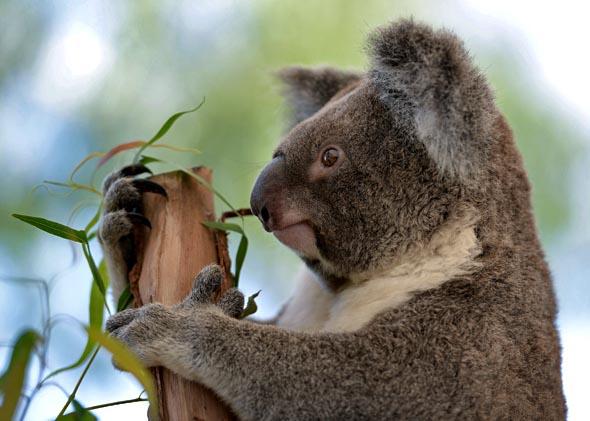Koalas are capable of making sounds much deeper than their size would suggest. Researchers have discovered that male koalas’ bellows, produced during breeding season to attract females, are so low in frequency because of a specialized vocal organ. The bellow suggests an animal the size of an elephant, not one the size of a human toddler.
The fact that sound frequency is related to size is rather intuitive. Mice aren’t squeaking in baritone, and lions don’t roar out in high-pitched squeals. The correlation between voice pitch and size, proposed in theory and observed empirically, is due to the length of an animal’s laryngeal vocal folds. These folds, part of the larynx, are longer in larger animals and shorter in smaller ones. Think of it like plucking a guitar string: the longer the string, the lower the note.
The male koalas examined in a new study in Current Biology had an average fold length of 9.8 millimeters. (Male humans’ are between 17 and 25 millimeters.) This fold length shouldn’t be capable of producing a fundamental frequency below 51 hertz—the number of sound waves per second—and would be expected to produce frequencies around 390 hertz. Yet the average male koala was producing bellows at 27.1 hertz. What gives?
Turns out koalas aren’t just using their larynx, or voice box—they are also using their pharynx, part of the throat above the larynx. They have developed “velar vascular folds” that run along an opening between the nasal and oral parts of the pharynx. Though normally wrinkled up, these folds can be pulled taut when a koala breathes in, allowing sounds as low as 9.8 hertz. This is only the second example researchers have uncovered of a sound-producing organ outside of the larynx in mammals. The other is in toothed whales, which generate clicks with phonic lips in their blowholes that they use for echolocation.
The bellows, which sound like a deep gurgling purr or a forced snore, are extremely important for male koalas. Competition to mate is fierce: The dominant male in the colony mates with all the females, leaving any other males waiting. Male koalas assert dominance over territory or females in two ways: fighting and bellowing. Without the most vicious fighting skills or the deepest bellow, a male koala will have to seek out new territory.
Female koalas have also been observed bellowing, but it is mainly a male behavior. All koalas can also make higher-pitched squeals, often heard as yelps of pain during fights.
A loud, deep bellow will become more and more important for male koalas as their habitat shrinks. The eucalyptus trees they rely on are being knocked down across Australia, often to make way for agricultural development or urban sprawl. The Australian government officially considers koalas a “vulnerable” species.
Koalas are outwardly cute, with their flapping ears and lazy demeanor. But the more you learn about them, the less cute they seem. They have weird, slimy glands on their chests that secrete their scent. They suffer from rampant chlamydia. And they utter the weirdest calls and most pathetic yelps. Maybe cute animals aren’t just jerks but also kind of gross.
Update, Dec. 2, 2013: This article has been updated to clarify that toothed whales use lips in their blowholes, rather than lips around their mouths, to make clicks.
